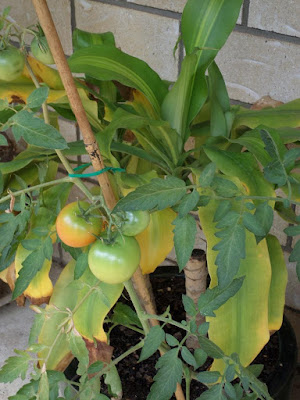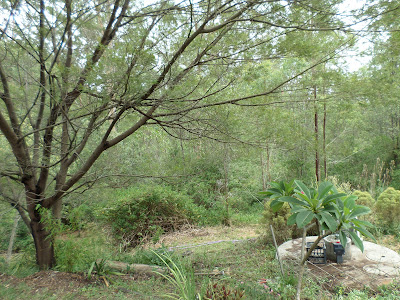Welcome to a new year! I was going to write about the things I wanted to accomplish in 2014, but decided to post what I was doing instead. And where else would I be, but the garden of course? It has endured some scorching heat recently (up to 44 degrees celcius). While I was a little worried about the garden, it was also an opportunity to test how our gardening strategies were going.
Newly mulched box hedge
Before I get to that however, I resurrected our box-hedge from the infestation of weeds around the septic tank recently. I like weeds and I try to live with them, but not when they're stunting the growth of other plants. This particular garden bed gets very little attention, so it has to cope on its own for the most part. Surprisingly, it's quite abundant (even in extremes) due to a few strategies, which are completely natural. If you notice the miniature fence in the image above, its to stop kangaroos crushing the growing plants.
Fresh roo-poo
Kangaroos leave little bundles of nutrients in their droppings, wherever they go. When we plant a new garden bed, we try to leave a little space for a kangaroo track. This particular garden bed is near a large tree - quite a magnet for kangaroos. By placing small barriers on the plants we don't want them to crush, but leave a more open space for them to meander, we get regular fertility compliments of the kangaroos. And fertility means, better soils which do much better in climate extremes.
So our first strategy has been to invite native animals into our garden, to be part of the nutrient cycle. Nature already put them into the landscape - we just had to accept their value and work our plans into that existing process.
Acacia tree (left) Small Frangipani (right)
If there is anything lacking on acreage, it's generally TREES. This large tree is the one I was referring to earlier. The septic tank is on the right. We were fortunate this acacia (left) sprung up on its own, and quickly grew into a wonderful canopy tree. It's wonderful, because canopy trees are nature's air-conditioners and escape from the heat. This tree has sheltered quite a few plants underneath it too.
Evolving landscape
I'm not sure if my garden will ever be "lush", but its beautiful watching it develop through the seasonal cycles. This cycad (front and centre) has been covered in weeds when it was a wee nipper too! It even got covered in the leaves and flowers shed from the acacia tree. When the cycad was young, it could've been overrun by so many natural elements, but instead it created a network of resilience for it to grow through.
If you notice in the picture, there's some old felled tree logs too. We don't believe in burning to rid ourselves of dead wood, because it only deprives the soil microbes, insects and lizards a place to take up residence. We deliberately placed those logs there, to stop soil erosion and capture moisture. Any insects which die under the log, will fertilise the cycad lower down.
So our second gardening strategy, has been to really use the life and death of plants to capture natural elements, in order to grow healthy soil. There's quite a lot involved in how you can use a plant while it's alive, and once it is dead. But the main thing is not to devalue what you have. Use it in the landscape instead - that is why nature put it there to begin with. The minute you find yourself asking, "how can I get rid of this", change your thought process to...how can I
"use" this instead?
Tree debris
Talk about using what you have, I truly get to appreciate the amount of debris that falls from our canopy tree, when I have to sweep off the top of the septic tank. And it all goes back onto the garden too.
What did I do with the weeds I pulled? I placed them in a heap, near where they were pulled. The reason the weeds are growing there, is nature's attempt to correct the minerals in the soils. By pulling the weeds and placing them nearby, I'm not breaking the natural cycle. Those minerals the weeds specialise in harvesting, are returning to the soil. If I cart those weeds away, I only have to bring something
else in, to correct the imbalance. Who needs that extra burden, when you're gardening on acreage?
Close-up view of acacia
Everything must return to the soil eventually. Even our wonderful canopy tree that has served this area immensely, is decaying. We have found a seedling which has sprung up nearby (only a few metres away) and it will replace this monolith of fertility one day. We will use it's gnarly trunk in the very garden bed it has brought to fruition. No doubt, we will build another track for the kangaroos to meander around, and plant more plants in the residue of its decay.
When you're gardening on acreage, your best friend is a tree. Or should I say...
trees! And don't forget the animals need a place to live too.
We are in the process of having to take a few trees out - we're pushing our human boundaries further into the landscape. But we have learned to balance the equation by inclusion. We use the elements which are already here, and cater for them to continue.
Have you stumbled across some natural gardening tips that work for your particular area?














